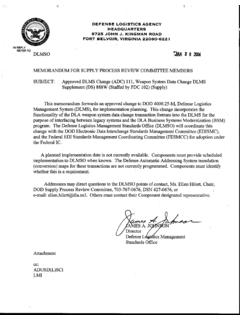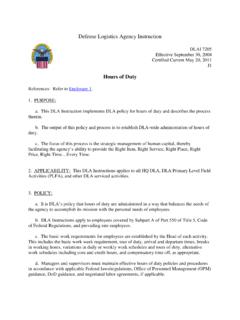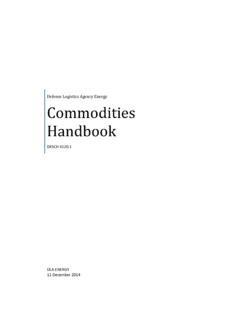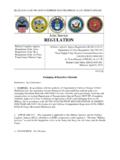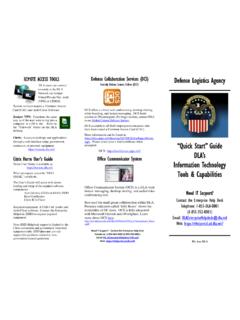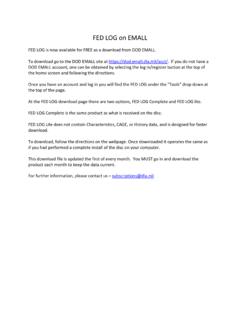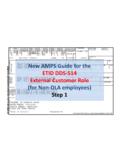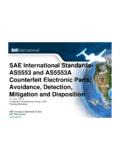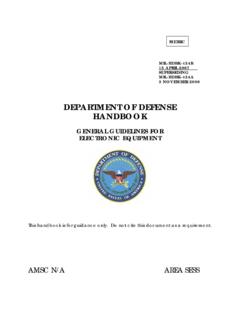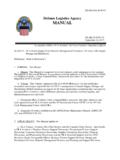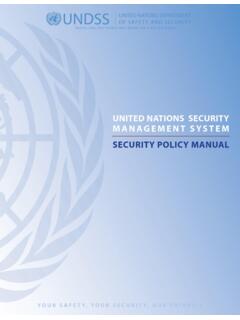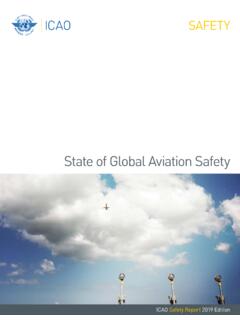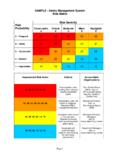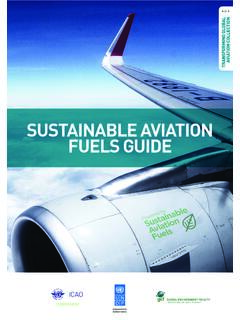Transcription of Aviation Source Approval and Management Handbook
1 Aviation Source Approval and Management Handbook 16 March 2011 NAVAIR Public Release 11-514 Distribution Statement A Approved for public release; distribution is unlimited CHANGE RECORD Change Number Section Page Description Date 16 March 2011 TABLE OF CONTENTS CHAPTER 1 General Information .. 1-1 Types of Sources Considered for Approval .. 1-2 CSIs from Unapproved Sources in Existing Inventory .. 1-4 Other Services Approved Sources ( Source Reciprocity) .. 1-5 Sources Identified on Control Drawings .. 1-5 Historical Sources of Supply .. 1-6 Local Purchase and Repair .. 1-7 Service Depots and Other Government Facilities.
2 1-7 Sources of Surplus Materials .. 1-8 Reverse Engineering and Reengineering .. 1-9 Parts Manufacturer Approval (PMA) Source of Supply ..1-10 Chapter 2 Procuring Activity Responsibilities in Source Management .. 2-1 Chapter 3 Source Approval Requests (SAR) .. 3-1 SAR Risk Management .. 3-1 SAR Development and Contents .. 3-2 Integrated Materiel Manager (IMM) Responsibilities .. 3-3 SAR Review .. 3-3 Cognizant Service ESA Responsibilities .. 3-4 Technical Review .. 3-4 Engineering Review .. 3-5 Manufacturing, Repair, Overhaul, Maintenance and Modification (ROMM) Review .. 3-8 Quality Assurance Review ..3-12 SAR Disposition ..3-15 Government Quality Assurance and Test Requirements ..3-15 Chapter 4 Reverse Engineering Process .. 4-1 Chapter 5 Alternate Source Site Survey.
3 5-1 Site Survey Checklist .. 5-2 Pre-Award Surveys .. 5-3 Repository for Past Site 5-3 Chapter 6 Source Validation and Disqualification .. 6-1 Revalidation of Sources of Supply .. 6-1 Re-qualification of Sources of Supply .. 6-2 Notification of Removal as Approved Source .. 6-2 Chapter 7 Government Manufacture of Critical Items (CI) .. 7-1 Government Manufacturing Authorization via Alternate Source Qualification7-1 Government Manufacturing via One-Time Manufacturing Authorization .. 7-2 CSI .. 7-2 CI, other than CSI .. 7-3 16 March 2011 APPENDICES Appendix I Acronyms .. I-1 EXHIBITS Exhibit A Source Approval Request Package Contents Guide .. A- 1 Exhibit B Example of SAR Review Checklist .. B-1 Exhibit C Site Survey Checklist .. C-1 Exhibit D Checklist for Surplus Procurements.
4 D-1 TABLES Table Reverse Engineering 4-1 16 March 2011 1-1 CHAPTER 1 General Information The Competition in Contracting Act (CICA, Public Law 98-369 and 10 United States (US) Code 2304), the Encouragement of New Competitors (10 USC 2319), the Federal Acquisition Regulation (FAR) Part 6 (Competition Requirements), and defense Federal Acquisition Regulation Supplement (DFARS) Part 206 (Competition Requirements) prescribes the policy and procedures that are to be used to promote and provide for full and open competition, with some exceptions. As defined in FAR , full and open competition, when used with respect to a contract action, means that all responsible sources are permitted to compete. Public Law 108-136 amended 10 2319 to establish that the head of a design control activity (DCA), rather than the contracting officer, is responsible for determining that Critical Safety Items (CSIs) or prospective CSI suppliers meet or could meet requirements.
5 It also directed that the Secretary of defense establish regulations stating that the head of a design control activity for Aviation CSIs establish processes to identify and manage the procurement and Repair, Overhaul, Modification, and Maintenance (ROMM) of Aviation CSIs, that the head of contracting activities enter into a contract only with sources approved by the design control activity, and that CSIs be accepted only if they meet all technical requirements established by the design control activity. In this Handbook the term Engineering Support Activity (ESA) is synonymous with the term DCA. FAR Part 9 (Contractor Qualifications) and DFARS Part ( Aviation Critical Safety Items) prescribe policies, standards, and procedures on contractor qualifications and Aviation Critical Safety The processes described in this Handbook focus on Source Approvals other than Qualified Products List (QPL) items and are intended to ensure that suppliers are capable of consistently producing and/or providing high quality, conforming items that meet design and manufacturing or ROMM requirements.
6 To implement the Aviation CSI Public Law, the military Services and defense agencies worked together to develop an instruction under the auspices of the Joint Aeronautical logistics Commanders, now called the Joint Aeronautical Commanders Group (JACG). The JACG is an organization comprising the highest levels of leadership from each Service s Aviation acquisition community and representatives from defense logistics agency (DLA), defense Contract Management agency (DCMA), Federal Aviation Administration (FAA), National Aeronautics and Space Administration (NASA), and Department of Homeland security . The CSI Instruction was issued by all Services and defense agencies under their respective regulation structures. Specifically, it was issued as SECNAVINST , AFI 20-106, DA Pam 95-9, DLAI , and DCMA INST CSI (AV) Management of Aviation Critical Safety Items , and is hereafter referred to as the 16 March 2011 1-2 Multi-Service/ defense agency CSI Instruction.
7 To supplement the instruction and provide implementing guidance regarding Management and Approval of sources for Aviation parts, the JACG also sponsored the development of the Aviation Critical Safety Item Management Handbook as well as this Sourcing Handbook . Additionally, a set of Frequently Asked Questions (FAQs), including some which refer to sourcing, can be found in Appendix III of the JACG Aviation CSI Handbook . For the purpose of this Handbook , the Aircraft Airworthiness Authority for each respective service is the Naval Air Systems Command, Assistant Commander for Research and Engineering ( ) for the Navy; US Army Aviation and Missile Command (RDMR-AE) for the Army; and the Technical Airworthiness Authority for the Air Force. The term Aircraft Airworthiness Authority is synonymous with DCA and ESA for the Army and Navy.
8 For the Air Force, the terms DCA and ESA are synonymous with the Designated Air Force Single Manager for a Weapon System. Types of Sources Considered for Approval Unless otherwise established by the cognizant Service ESA, only sources in the categories listed below are to be considered for Approval : System or subsystem prime contractor. System or subsystem prime contractors are approved sources for the items in their systems or subsystems, unless specifically disapproved by the cognizant Service ESA; Actual manufacturer ( , Original Equipment Manufacturer (OEM)) that supplies items to the prime Contractor where the cognizant Service ESA determines the prime Contractor provides no value added to the item. Section of the JACG Aviation CSI Handbook provides specific guidance for evaluating OEM s processes.
9 The Service and DLA logistics organizations and defense Contract Management agency (DCMA) assist the cognizant Service ESA in assessing value added ; Fully-licensed manufacturers of the prime contractor or of the OEM that provide substantiation of their licensing arrangement, as validated by and acceptable to the cognizant Service ESA; Fully-licensed repair/overhaul facilities of the prime contractor or of the OEM that provide substantiation of their repair/overhaul arrangement with the prime contractor, as validated by and acceptable to the cognizant Service ESA; Distributors approved by the cognizant Service ESA who provide traceability that the items they are supplying were produced by the system prime contractor, OEM, or a cognizant Service ESA-approved alternative Source according to technical and quality requirements and are unchanged in any way.
10 Approval of a distributor is based upon the traceability to an approved Source and Approval of the distributor will be removed from the approved 16 March 2011 1-3 Source list if the distributor changes their proposed Source after Approval . Additional guidance and a possible Source of distributor accreditation criteria may be found in FAA Advisory Circular 00-56A, Voluntary Industry Distributor Accreditation Program, which describes a voluntary system for the accreditation of civil aircraft parts distributors for parts and products installed on type-certificated products. Also, ASA-100, Quality System Standard, is a commercially available dealer/distributor Approval standard which the FAA determined meets and/or exceeds their accreditation criteria; and SAE AS9120, Quality Management Systems - Aerospace Requirements for Stocklist Distributors, a commercially available standard which includes ISO 9001:2000 quality Management system requirements and specifies additional requirements for a quality Management system for the aerospace industry and is applicable to stocklist distributors; Sources identified on a Qualified Products List (QPL), Qualified Products Database (QPD) or Critical Item Procurement Requirements Document (CIPRD) where the cognizant Service ESA coordinated on the Approval .
